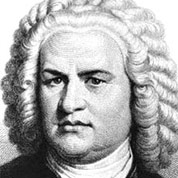Marche in D (Anh122) by Johann Sebastian Bach (1685-1750)
Grade 4-Late Intermediate
 Johann Sebastian Bach was a German composer, organist, harpsichordist, violist, and violinist whose sacred and secular works for choir, orchestra, and solo instruments drew together the strands of the Baroque period and brought it to its ultimate maturity. |



Notes
Marche in D is originally written for the harpsichord. This piece is taken from Anna Magdalena’s Notebook, Bach’s gift to his second wife. and a prized possession of the Bach household. Marche in D possess the characteristic earmarks of Bach’s music in both the catchy nature of the tune and its particular use of counterpoint (2 or more lines of melody sounding simultaneously). For the solo guitar, a counterpoint can create voices sounding like it came from multiple instrument.
Drop D tuning. First 3 bars, hold note to fill the texture. Part A Bar[9] A chord and Part B Bar[13] D chord. Correct fingering on the right hand is important to generate speed. Pluck the chord in rapid succession and end on the highnote. Part A is much easier than Part B. The latter has a long chain of melody playing bach’s signature conterpoint. 2 or more melody played at once. Suspend the bass and keep in time. Part B, Bar[5]-end is the hardest section of the song. Start slow to avoid playing “catch-up” towards the end.
